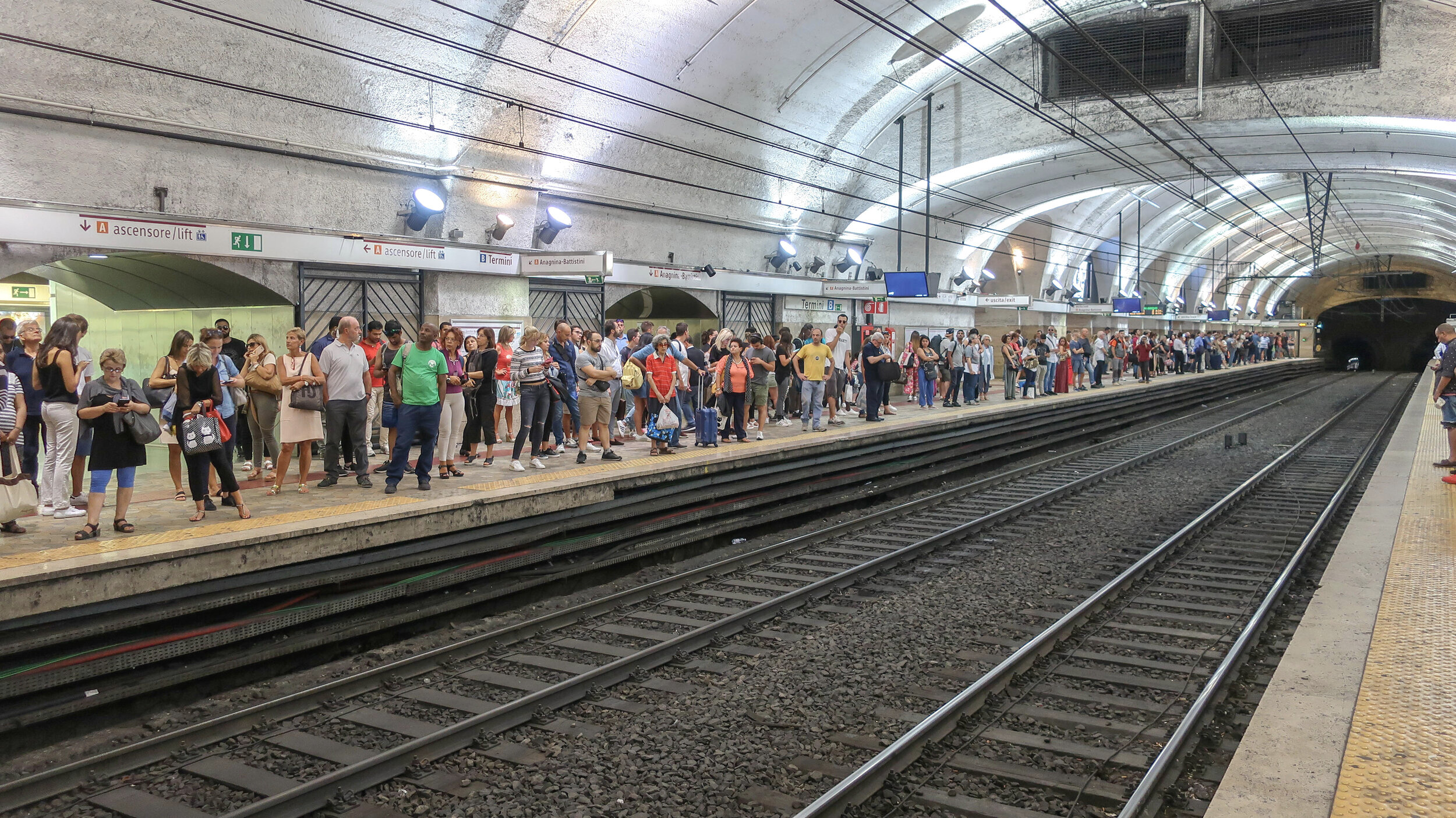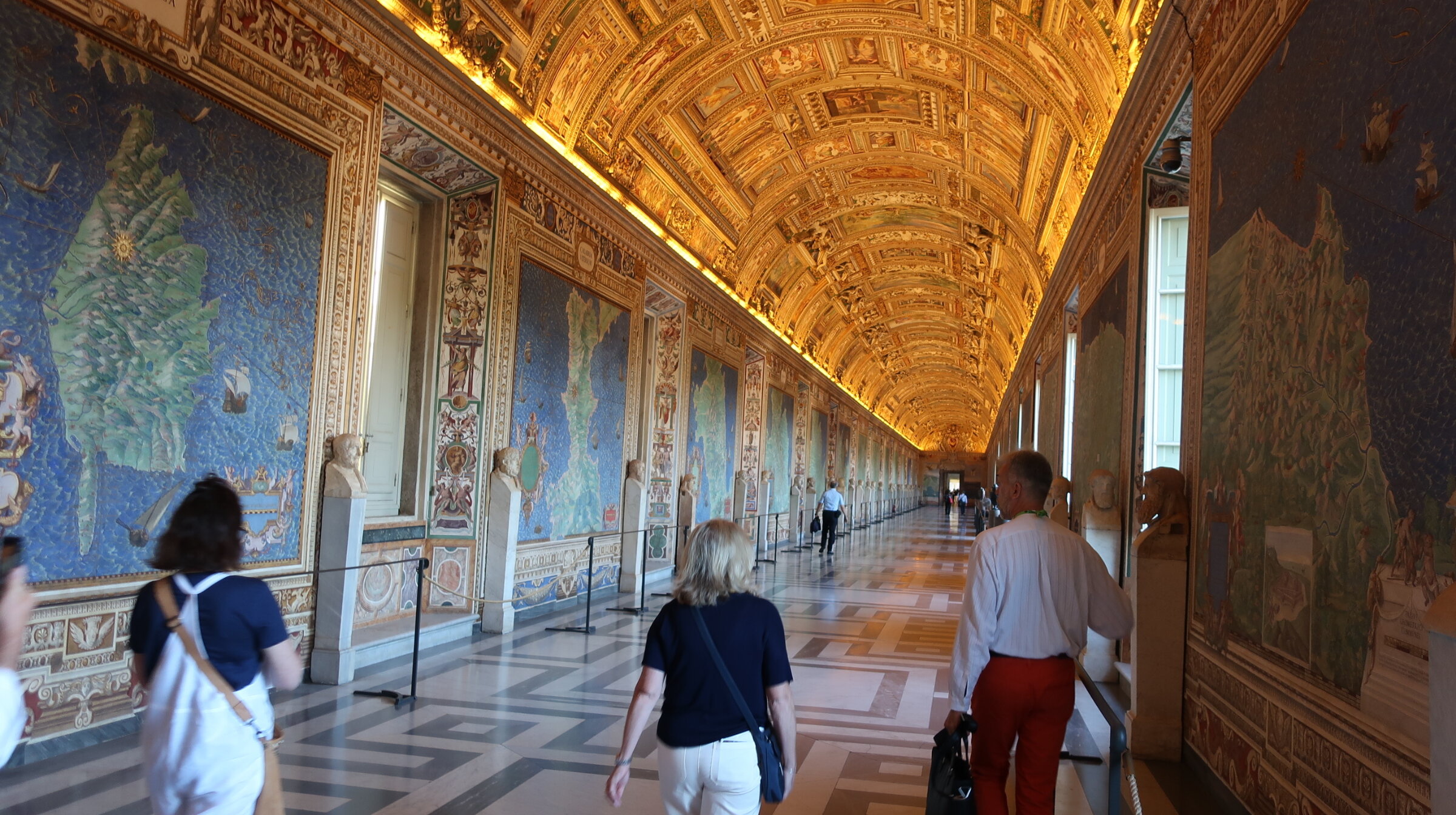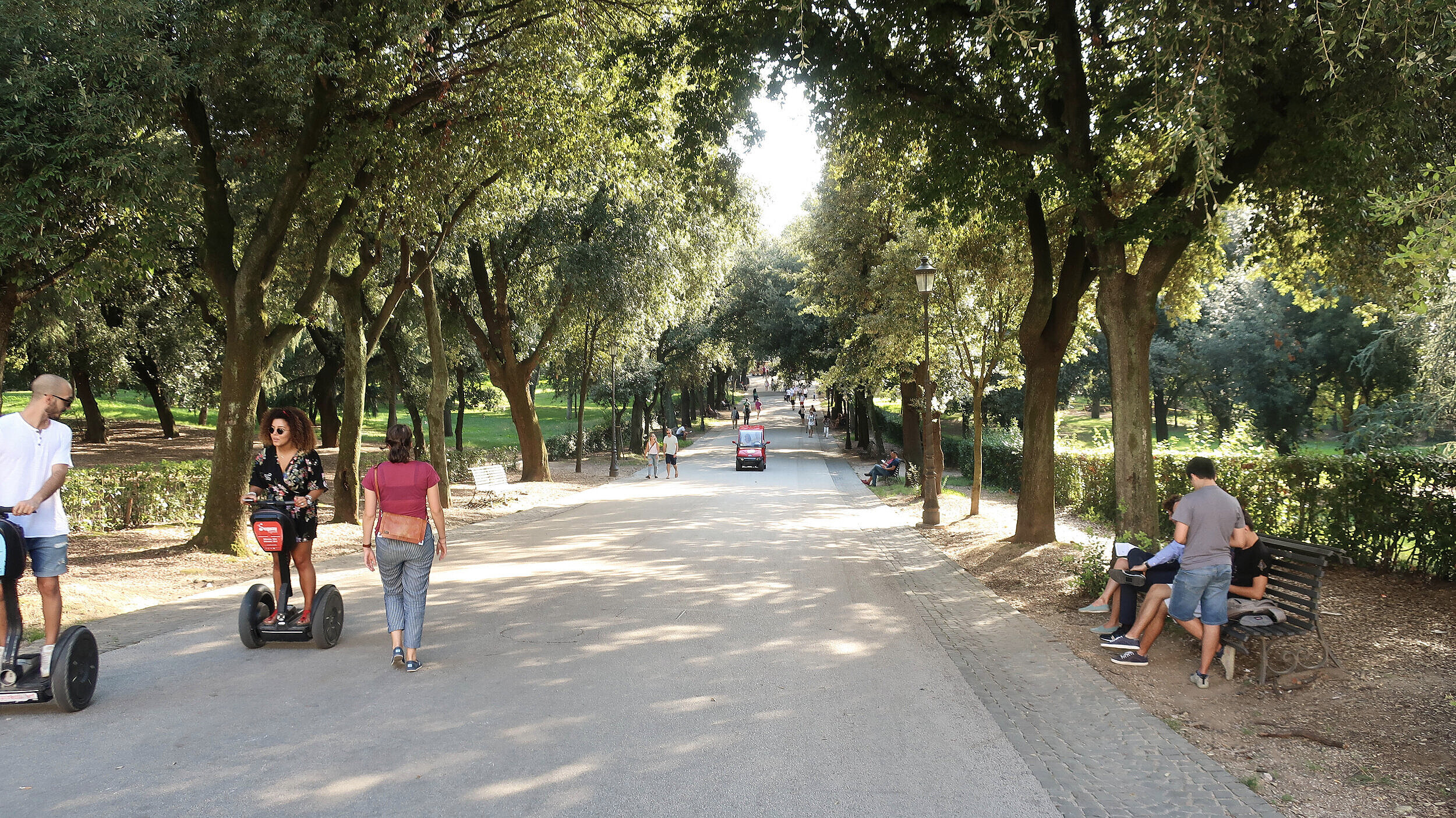Your First Stop, Rome
The Best of Rome in 3 Days
I’m not going to give you a history lesson.
But you should know a few things about Rome before you arrive.
First, Rome is big but highly walk-able. From the Spanish Steps in the north of the city to The Colosseum in the south is only about two and a half miles. Get ready to walk - even using the Metro and buses you’ll be on your feet a lot.
Second, Rome is a big city so it’s going to be crowded, at times obnoxiously so but never without a seductive charm. Just accept that. It’s busy. All the time.
Third, Rome will take your breath away with its sights, the ancient ruins, the magnitude of it’s riches in arts, culture, food, and, yes, history. There’s a lot of history here. It won’t kill you to watch a bit of Rick Steves before you arrive. Once there, take your time, spend a few days. It will be worth every second.

Roma Termini connects to the metro lines
Flying to Rome
Fly into Rome Fiumicino (FCO), Italy’s largest airport.
Once you land you need to get to the main area of Rome, roughly 30 minutes away. You can take a taxi, approximately €50, or you can take the airport train called The Leonardo Express for €14. The Leonardo Express will take you non-stop to Rome’s main train station, Roma Termini. Make sure you validate your ticket before boarding the train. You do not want to start your vacation with a big fine.
Catch a Metro
Once you are in Roma Termini you can either walk outside and grab a taxi, or figure out which metro gets closest to your hotel. Here is a good basic map with the attractions and metro stations on it. You can also use google maps and select the train option and it will show you the metro stops as well. Ask your hotel which station is closest and map the walking path from the station to your hotel.
What Did We Do?
We took a cab. I knew we would be tired, excited, jet lagged, and confused. I just wanted to be dropped off in front of my hotel where we could drop off our bags and start exploring. My hotel set it up - We paid 50€ from airport to hotel versus €28 for the train. Worth it in my book. Of course now that we know our way around I might take the train next time but for first timers just do what we did and take a taxi.
How We Picked our Hotel in Rome
Breakfast at our hotel was downstairs at a nice little cafe.
Not knowing anything about Rome or Italy we had no idea where to stay - it’s not like the US where there are Marriott’s and Embassy Suites everywhere. So in picking our hotels we followed these rules:
Location was key. Our hotel picks must be close to the train or metro station because we knew we would be on our own getting there and back. We also wanted our hotel to be walking distance to restaurants and attractions.
While we reserved on booking.com, we studied reviews from TripAdvisor, Expedia, etc. We scoured the web looking for good - and bad - reviews.
We set our price limit at $250 a night. In the US we normally stay at 3 or 4 star hotels, basically a Marriott level hotel. We opted not to book super fancy or extravagant hotels or resorts as we knew we would not be spending that much time in them.
Where We Stayed in Rome
In Rome we stayed at Town House Spagna. I’m not going to tell you that this is the best hotel choice because it might not be. But it was 5 minutes from the Metro, it was close to the Spanish Steps, and there were restaurants up and down the street. Rooms were clean, comfy, and though a bit odd by US standards (the round bed platform made for lots of toe stubbing) I’d stay there again if just for the location.
Alternatively, our friends stayed at The Glam hotel. It’s a bit higher end with a balcony roof bar with a killer view, they loved it and highly recommend it.
Roaming Rome
With limited time we had to accept we couldn’t see it all. We tried to group the attractions into the same geographical area to max out our time. Make sure you wear really comfortable shoes. While you can take the Metro to get from one area of town to the other the metro stations are not always in the most convenient places. Here is how we grouped the attractions we wanted to see.
Rome Colosseum and The Forum
Vatican City, Sistine Chapel, St. Peter’s Basilica
Trevi Fountain, Pantheon, Piazza Navona, Campo de’ Fiori
Borghese Museum, Villa Borghese (park), The Spanish Steps

The Colosseum
The Colosseum
We made our first stop one of the most impressive sights we had ever seen, The Roman Colosseum. Built in 70 AD, you can almost envision the brutal gladiator fights and other bloody spectacles that took place here. The original floor is now gone, allowing you to peer down into the walled area that once housed wild animals and prisoners waiting in queue to fight to their deaths.
With so much history you’ll want to either do an official tour or do what we did - download the free Rick Steves audio tour. The free audio tour gave us a good appreciation as to what we were seeing and allowed us to unplug when we had enough of Rick and just explore on our own.
Tickets
Whatever you do, do not just show up at the Colosseum and hope you can walk in. Lines for tickets alone can be brutally long. We used The Roma Pass and skipped though all of the long lines but looking at their site in 2021 it’s not clear whether they still offer the Colosseum and Forum on the pass. Do your homework, but basically do not show up without some sort of ticket or pass.
Free Days?
Yes, there are certain days when the Colosseum is free of charge. Before you get too excited I would avoid these days as the crowds are about as crazy as you might imagine. Make sure you check out their schedule so you don’t mistakenly plan your visit during a Free Day.
The Roman Forum and Palatine Hill
Located next to The Colosseum, The Forum is another “must see” attraction and is included with admission. The ancient city ruins hold lots of intrigue as to how life in Rome once was. Palatine Hill is connected to The Roman Forum and is also included with the standard admission ticket.
Avoiding the Crowds: Either arrive at 8:30 when they open or a couple of hours before they close. Closing time is sundown. We arrived around 3 PM and had no issues at all with the crowds once inside. We spent an hour or so at each site which was plenty of time to absorb it. We did this on our first day after checking into our hotel. We’ve made the mistake of waiting until the last day to visit a key attraction, only to find it closed. Now we do the key attractions first.
The Mouth of Truth (as seen in The Roman Holiday)
If part of the romance of visiting Rome was induced by watching Audrey Hepburn and Gregory Peck in The Roman Holiday then you probably should take the sort walk to Bocca della Verità, pay your €2 and stick your hand in the mouth of this stone disc. I just couldn’t put myself up to that but there you go, it’s right there.

Visiting Vatican City
Visiting The Vatican City, Sistine Chapel, and St. Peter’s Basilica
I am going to admit something. I wasn’t thrilled about visiting The Vatican City. I was more interested in finding the best pizza than I was in visiting the religious center of the Catholic church. Getting up before the crack of dawn to be there by 7:30 AM also wasn’t improving my attitude. But I was wrong. Oh so wrong. The overflowing art, the shear magnitude of the riches, and the Sistine Chapel with the ceiling painted by Michelangelo, holy cow, it’s impressive. The Pope was there like a rock star, and when I entered St. Peter’s Basilica my head was twisting like Linda Blair just trying to take it all in. It is incredible. Mind blowing incredible.
We normally don’t like guided tours but we booked with The Roman Guy and recommend it. We got in an hour early which meant no crowds. The photo above was our entry to the Sistine Chapel. Just a few hours later the same hallway was wall to wall people. The Roman Guy explained everything we were seeing in an enjoyable way and the group size was small, under 14 people. Very nice.
Women - They are not kidding when they say you need your shoulders covered and skirts must cover your knees. Unlike Catholic school where disobeying meant a rap on the knuckles, at Vatican City it means No Tour For You so dress appropriately.
Immense, impressive, St. Peter’s Basilica is a sight to see
The Reason Why You Can’t Take Photos of The Sistine Chapel? Restoring Michelangelo’s masterpiece ceiling cost over $4M and took 20 years, renovations starting in 1980. To defray the costs (which seems odd after seeing the opulence of the church) they went out for bids and Nippon Television Network of Japan paid the bill - in exchange for owning all photo and video rights. This has since expired but it seemed much simpler to keep with the “no photo” rule to protect the ceiling from camera flash damage.
Castel Sant’Angelo
The towering cylindrical castle-like building that you pass after exiting St. Peter’s Basilica is Castel Sant’Angelo, initially commissioned to be a mausoleum but later used by the popes as a castle and fortress - and now a museum and tourist attraction that’s discounted with your Roma Pass. After a visit make sure you cross the Ponte Sant’Angelo, aka The Bridges of Angels, one of Rome’s most beautiful bridges.

The Pantheon
The Pantheon, Open Since 126 AD
One of the few major attractions that is still free, The Pantheon is a Catholic church that has been in continual use since 126 AD. I’m sure you’ve seen photos of the giant dome with the hole for light in the middle. An architectural marvel when you consider the lack of technology (but abundance of slaves) it took to create the worlds largest un-reinforced concrete dome. And yes, the Romans invented concrete. I’ll leave the rest of the fun facts for you to discover on your own (Rick Steves free Audio Tour to the rescue, again).
Because it’s free you need to arrive early to avoid crowds.
Piazza Navona
Nearby Piazza Navona is a historical public place, built in the first century and now a great place to grab lunch or to just people watch. You’ll be walking by, just stop in to check it out.
Seems like all around Rome are these continually running water fountains with people drinking from them or filling water bottles. You might be reluctant at first - after all, a lot of people in the US are totally convinced that water comes from plastic bottles. But these water fountains, called Nasoni, have been quenching Romans' thirst since 1870. Coming directly from the mountains, it's unprocessed, clean, water. And it's tested. Stop worrying. Tip: If you don't have an empty water bottle just hold your finger under the spout and the water will shoot up like a drinking fountain.
Hanging with the locals at Campo de Fiori
Campo de Fiore
I love going to local markets when on vacation to experience the local scene. OK, some will argue that Campo de Fiore has become a bit of a tourist attraction but we enjoyed talking with the locals and later grabbing a seat at a cafe to sip our first Italian Spritz, a slightly bitter drink made with Aperol and Proscecco and looking like a bright orange sunset. Plenty of food options for snacks so come hungry and have fun tasting your way around the square.
Are we in Las Vegas? No, it’s Trevi Fountain packed with tourists!
Trevi Fountain
Oh my goodness, did every tourist bus just drop off everyone at the same time? Welcome to The Trevi Fountain, one of the biggest tourist attractions in Rome that everyone must go to, including you. The story is you toss a coin over your shoulder and you will return to Rome. We did that. I’m glad we did but 10 minutes later we were out of there, our photos taken, our coins tossed, and hightailing it to get a gelato. Don’t get me wrong, it’s impressive, even if it does look like something out of Las Vegas. But the tourist crowds were insane when we were there, just nuts.

Galleria Borghese and Gardens
Villa Borghese Gardens and the Borghese Museum
The Galleria Borghese Museum (make reservations, included with the Roma Pass) is filled with sculptures and other works of art. Well, you can probably tell I wasn’t paying close attention because after Vatican City I was getting a bit burned out on visiting museums. But even with my self imposed attention deficit there was much to see and appreciate there. The ceilings look like 3-D statues but are actually painted. And the sculptures and art, spread about in 20 rooms on two stories, are historical masterpieces that you normally only see in photographs.
Apollo and Daphne, Bernini, 1622 - even turning into a tree did not sway Apollo’s love.
After an hour in the museum we explored the gardens and park. Start at the museum and then meander towards The Spanish Steps. Here’s the path we took, purely at random but now in hindsight a pretty much perfect route. Basically your goal is to get to Terraza del Pincio, a lookout area with a view of Piazza del Poppolo. It’s about a 2 mile walk from the museum to The Spanish Steps. After all the crowds at Trevi Fountain you’ll love the peace and quiet of the park. Enjoy it, it won’t last as you shall see.
The Spanish Steps
Sitting on the Spanish Steps no longer allowed
After the calming walk in the gardens the sight of The Spanish Steps might take you aback. But go with the flow, get into it, and walk down the marble steps completed in 1717. Just don’t sit down - as of 2019 you can no longer sit or eat on the steps as we did. And they are serious about this so avoid the fine and keep walking. There are plenty of shops, restaurants, and things to see and do in the area.
Tip: Be on the lookout for aperitivo, basically the Italian version of Happy Hour but with much better complimentary snacks.
The Time Has Come….
Is it already time to leave Rome? The excitement, the crowds, the pace, after three days it’s enough. For this trip, at least. My coin toss at Trevi Fountain guarantees a return trip so I’ll see you soon, Rome.
Things We Missed
You learn from mistakes and I think we did pretty well in seeing most of Rome. However, there were a few things we wished we could have squeezed in.
Trastevere
The quieter side of Rome across the river, roaming the quaint village and cobblestone streets of Rome’s funkier side was high on our list. We went during the evening, a huge mistake as we didn’t know any of the landmarks and ended up dining at one of our worst meals of our trip.
Next time we know better - head to Piazza Santa Maria and explore from there, during the day, and then stay for dinner. Where to eat? We did not eat at Da Enzo but walked past it a dozen times. Later we found out it is one of the best.
Supplì
Not a place but a thing to eat, supplì are the crispy fried ball of rice filled with meat, tomato sauce, and gooey, stringy molten cheese. A popular street food and only found in Rome, I don’t know how we missed them. Similar to arancini though I am told quite different, I can only imagine how good they are. Do yourself a favor and search these out and email me what you thought of them!











